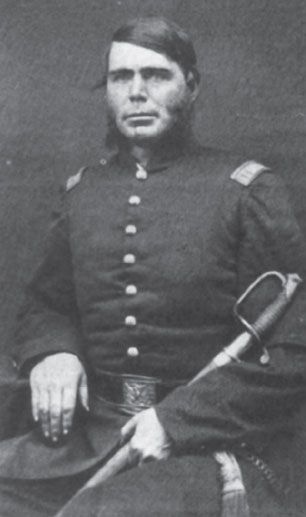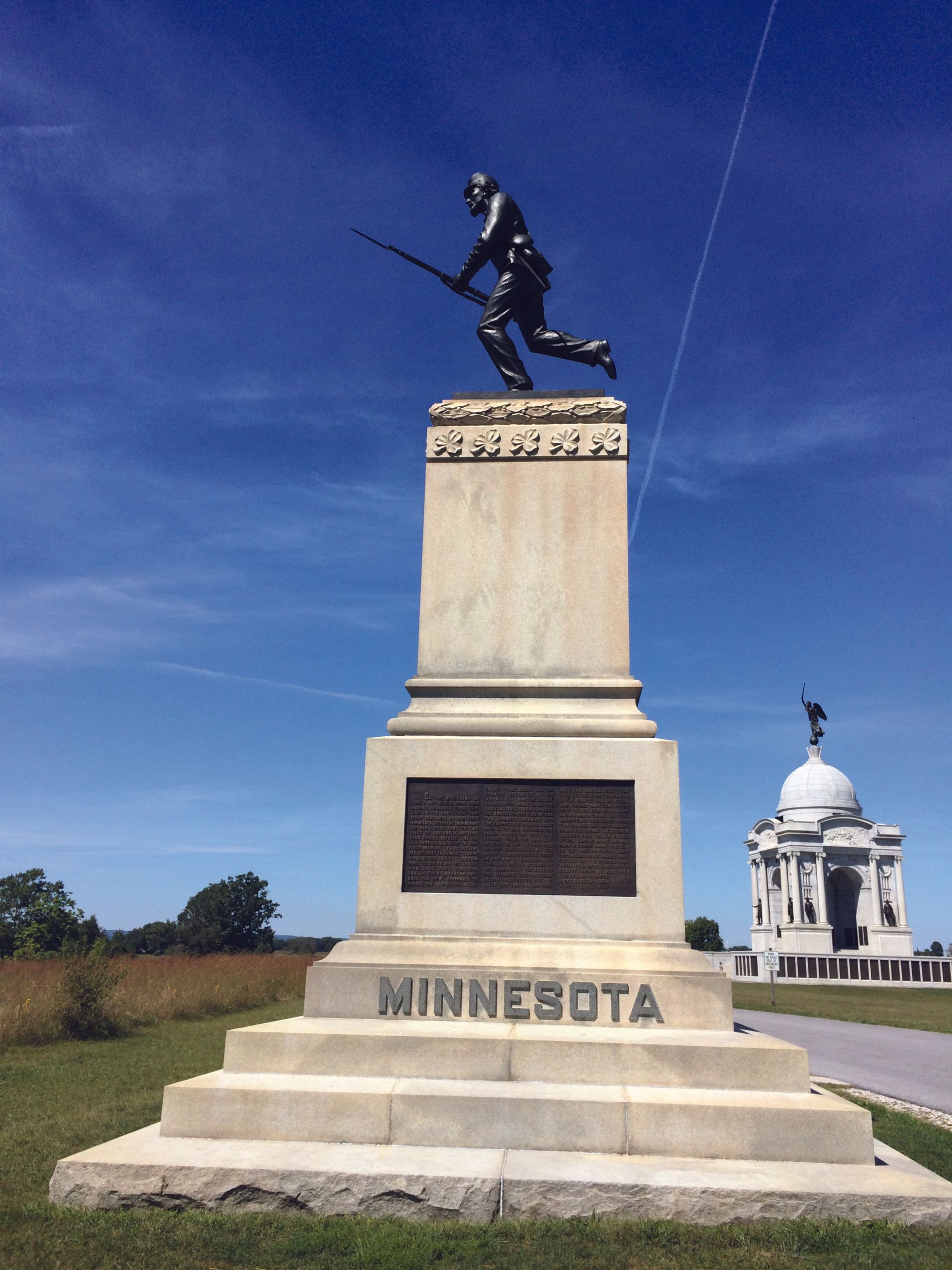William Colvill: No Grander Heroism
by Diana Loski
The 1st Minnesota Monument,Gettysburg
(Author Photo)
“ There was a gleam of light, in which my glance took in a slope on my left. I saw numbers of our men lying upon it as they had fallen
,” Colvill wrote. “ Then came a shock like a sledge hammer on my back bone between the shoulders.” 12
A piece of shrapnel had hit Colvill on the left shoulder, and traveled downward to his spine. As he turned over command to Captain Coates, he felt a sharp pain in his right foot. A bullet had hit his ankle, and he fell, unable to walk. “ I saw just beside me a gully
,” he remembered, “ not more than two feet wide…as I struck the ground I rolled over into it, and listening among other things the bullets ‘zipping’ along the ground.” 13
With the arrival of additional Union troops, the Alabama brigade withdrew. The First Minnesota had succeeded, at a heavy cost.
General Hancock later said of this valiant group: “ I had no alternative but to order the regiment in. We had no force on hand to meet the sudden emergency….I saw that five minutes must be gained or we were lost. It was fortunate I found there so grand a body of men as the First Minnesota. I knew they must lose heavily and it caused me pain to give the order…but I would have done it if I had known every man would be killed.” 14
It was miraculous that any of the Minnesotans survived. Colvill, unable to move, lay in the gully until darkness overcame the dusk, and for a time he watched the stars. He soon heard voices that he recognized. Men from the regiment returned to the battle site, hoping to find some of their number yet alive. They were glad to find their colonel among the living, although his wounds were dangerous ones.
The surviving Minnesotans were engaged in the fight against Pickett’s Charge the following day. More were killed in the fight, including Captain Coates. Colvill, too severely wounded, spent the day in a field hospital in great pain.
“ A few days after the battle
,” wrote Gettysburg civilian Tillie Pierce, “ several soldiers came to our house and asked mother if she would allow them to bring their wounded colonel to the place.
” The kindly Margaret Pierce consented, even though additional wounded men were already in the Pierce’s home on Baltimore Street. Soldiers soon carried in Colvill on a litter. “ After they got him up the stairs, and were…placing him on the bed, it was found to be too short, so that the footboard had to be taken off and an extension added.” Tillie explained, “ The colonel was a very tall man.” 15
Two men, detailed as nurses for the colonel, remained to help with his recovery in the Pierce home. The surgeon wanted to amputate Colvill’s foot, but Colvill refused. When the surgeon insisted that it was necessary to save his life, Colvill replied that if his foot went, he would go too. 16
In addition to the devoted nursing of Mrs. Pierce and the two regimental nurses, Colvill’s sister, Elizabeth, made the journey from New York to Gettysburg, which cheered him greatly. Several monthslater, he was able walk. He left for Minnesota on a pair of crutches. He would walk with a cane for the rest of his life. 17
“ He was highly esteemed by all his men
,” Tillie Pierce remembered, “ many of whom visited him at the house, and even wept over him in his suffering.” Undoubtedly some of them felt pangs of guilt for causing him such trouble over crossing the stream only days earlier. For the regiment’s unequalled bravery at Gettysburg, the colonel did not have to face a court martial for the transgression in Maryland. 18
After a long recovery, Colvill served for a time with the Minnesota Artillery before his three-year term ended in the spring of 1864. He returned to his adopted state and again published his newspaper. In 1865 he was brevetted a U.S. Major General for “ gallant and meritorious services
” during the war. He returned to Gettysburg in 1866 to tour the battlefield, and spent a few moments visiting with the Pierce family on Baltimore Street. He married Jane Morgan in 1867, and continued to work in Red Wing. He served two terms as the Attorney General of Minnesota, and often attended regimental reunions, where he enjoyed the company of his fellow compatriots. He was, however, reluctant to talk about Gettysburg. The loss of so many of his men remained a subject that was too painful to discuss. 19
Colvill and his wife had no children, and she predeceased him in 1894. “ He was alone in the world
,” one contemporary recalled. Colvill remained active in his friendships, and with his newspaper business. 20
On June 12, 1905, the seventy-five-year-old Colvill attended a meeting for a planned reunion with the Old First. He oversaw the removal of the regimental battle flags from the old courthouse to the newly built one to stand during the celebration. “ He retired at 10 o’clock, apparently in the best of health
” at the Soldiers’ Home at Fort Snelling, in anticipation of the reunion the next day. 21
The next morning, William Colvill was found dead in his bed of an apparent heart attack. His death cast a terrible pall on the reunion, and the usually stoic men of the Old First wept at the news. 22
The courageous old soldier was buried with military honors at Cannon Falls Cemetery.
From his beginnings in a small village in western New York, and bravely making his way alone to the frontier, the tall Minnesotan had proven his worth at a pivotal field in an epic moment at Gettysburg. It is for that heroism where he faced certain death and somehow survived that William Colvill will always be remembered.
While Gettysburg was a battle filled with exceptional heroism on many facets, the charge of the First Minnesota, led by their intrepid colonel, is at the forefront. “ No soldiers, on any field, in this or any other country
,” averred General Hancock, “ever displayed grander heroism.” 23
He is absolutely correct – and he would know.
The James Pierce House, where Colvill
convalesced after the battle
(Author Photo)
Sources: Alleman, Tillie Pierce. At Gettysburg: Or What a Girl Saw and Heard of the Battle . Gettysburg, PA: The Shriver House Museum, 2015 (reprint, first published in 1889 by W. Lake Borland, New York). William Colvill Family Tree, Ancestry.com. William Colvill Military Records, Minnesota U.S. Civil War Records, 1861-1865, National Archives, Washington, D.C. The Evening Post, New York, NY, 13 June, 1905. Johnson, Frederick, “Minnesotan William Colvill: A Hero of Gettysburg”, The Minn Post/google.com. Moe, Richard. The Last Full Measure: The Life and Death of the First Minnesota Volunteers . New York: Avon Books, 1993. Pfanz, Harry W. Gettysburg: The Second Day . Chapel Hill, NC: The University of North Carolina Press, 1987. Sempa, Francis. “Forgotten Heroes of Gettysburg”, The Tribune, Scranton, PA, 30 May, 2005. Tucker, Glenn. Hancock The Superb . Dayton, OH: Morningside Bookshop, 1980. The U.S. Census, 1870, 1880. The Virginia Enterprise, Virginia, Minnesota, 30 June, 1905. Historic newspapers found at newspapers.com.
End Notes:
1. Alleman, p. 102. The Evening Post, 13 June, 1905. While there were more men than 262 at Gettysburg, three companies had been detailed else-where.
2. U.S. Census, 1870. Colvill Family Tree, Ancestry.com. Moe, p. 11.
3. The Evening Post, 13 June, 1905. While there is no certainty which regiment was the absolute first to enlist, it appears that no one has challenged the First Minnesota, and many books and periodicals echo the claim of The Evening Post.
4. Colvill Military Records, NA. Colonel Gorman led the Minnesota regiment, and Colvill was a company captain at the start of the war.
5. Johnson, p. 1. Pfanz, p. 446.
6. Pfanz, pp. 17-18.
7. Ibid. p. 451.
8. Ibid., p. 410.
9. Ibid.
10. Sempa, p. 1. The Virginia Enterprise, 30 June, 1905.
11. Moe, p. 271. The Tribune, 30 May, 2005.
12. Moe, p. 271.
13. Ibid., p. 272.
14. Tucker, p. 144.
15. Alleman, p. 101.
16. Ibid.
17. Ibid., p. 102.
18. Ibid, p. 103.
19. Colvill Military Records, NA. Alleman, p. 103. U.S. Census Records, 1870, 1880. Colvill Family Tree, Ancestry.com. Moe, p. 310.
20. The Virginia Enterprise, 30 June, 1905.
21. Ibid.
22. The Evening Post, 13 June, 1905.
23. Tucker, p. 145.





